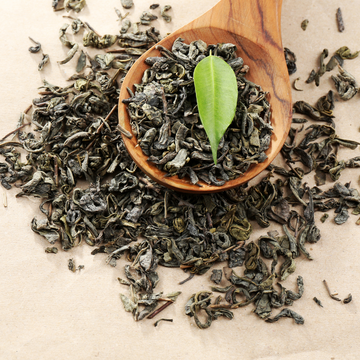Whether you're a casual tea drinker looking to switch to a healthier option or a devoted tea connoisseur, understanding the caffeine content in green tea is vital. We'll explore the various factors that influence the caffeine levels in your cup, such as the type of green tea, the brewing method, and even the tea leaves' picking time.
To fully understand the caffeine content in green tea, our guide will delve into the science behind this stimulant and its effects on the body. Whether you're looking for a boost of energy or seeking to reduce your caffeine intake, we'll provide practical tips and alternatives to help you make informed choices.
Join us on this journey as we demystify the caffeine content in green tea, empowering you to make the best choices for your health and wellness.
What is caffeine?
Caffeine is a central nervous system stimulant that is widely consumed around the globe, primarily for its ability to enhance alertness and reduce fatigue. It is found naturally in various plants, including coffee beans, tea leaves, cacao pods, and kola nuts. The chemical structure of caffeine is similar to that of adenosine, a neurotransmitter that promotes sleep and relaxation. When caffeine enters the bloodstream, it competes with adenosine for binding to its receptors. By blocking adenosine's calming effects, caffeine promotes wakefulness, leading to increased energy and alertness.
In moderate amounts, caffeine can provide several benefits, such as improved mental focus, enhanced physical performance, and even a temporary boost in mood. However, it’s important to recognize that caffeine affects individuals differently, influenced by factors like genetics, tolerance, and overall health. For some, caffeine can lead to side effects such as jitters, increased heart rate, or disrupted sleep patterns, making understanding its effects crucial for both casual consumers and avid enthusiasts.
In addition to its stimulating properties, caffeine also has a significant role in the beverage industry, particularly in coffee and tea. While coffee is often lauded for its higher caffeine content, tea, especially green tea, offers a more complex profile of caffeine and other beneficial compounds. This complexity is what makes understanding caffeine in green tea particularly interesting, as it combines the stimulant effects of caffeine with a variety of health benefits attributed to its unique phytochemical composition.
Caffeine content in green tea
The caffeine content in green tea can vary significantly, typically ranging from 20 to 45 milligrams per 8-ounce cup. This variability is influenced by several factors, including the specific type of green tea, its brewing time, and the water temperature used. For instance, matcha, a powdered form of green tea, generally contains higher caffeine levels due to the consumption of whole leaves, while steeped varieties may have lower concentrations. Understanding these nuances is essential for those who are conscious of their caffeine intake.
Moreover, the way green tea is processed can also impact its caffeine levels. The leaves used for green tea undergo minimal oxidation and are typically dried quickly after harvesting, preserving their natural compounds. However, the age of the leaves, the growing conditions, and how they are harvested can all contribute to differences in caffeine content. Younger leaves, for example, may have higher caffeine levels compared to older ones, as they are often richer in beneficial compounds.
For tea drinkers looking to monitor their caffeine consumption, it's worth noting that how green tea is brewed can significantly affect its caffeine extraction. A longer steeping time or higher water temperature can lead to a more potent infusion, resulting in a higher caffeine content. Therefore, adjusting these variables can help you achieve a desired caffeine level in your cup, tailoring your green tea experience to your personal preferences and sensitivity.
Health benefits of green tea
Green tea is renowned for its multitude of health benefits, many of which can be attributed to its rich composition of antioxidants, vitamins, and minerals. One of the most notable groups of compounds in green tea is catechins, particularly epigallocatechin gallate (EGCG). These powerful antioxidants help combat oxidative stress in the body, potentially lowering the risk of chronic diseases such as heart disease, diabetes, and certain cancers. The anti-inflammatory properties of catechins further enhance their protective effects, promoting overall health and wellness.
In addition to its antioxidant capabilities, green tea has been linked to improved brain function. The combination of caffeine and L-theanine, an amino acid found in tea, creates a synergistic effect that enhances cognitive performance. While caffeine provides a boost in alertness, L-theanine promotes relaxation without drowsiness, resulting in improved focus and a more balanced mental state. This unique combination is particularly appealing to those seeking a calmer yet more alert state of mind.
Furthermore, research suggests that regular consumption of green tea may aid in weight management and metabolic health. Studies have shown that the catechins in green tea can boost metabolic rates and increase fat oxidation, making it a popular choice among those looking to lose weight or maintain a healthy lifestyle. Additionally, green tea is often associated with improved cardiovascular health, as it can help lower cholesterol levels and support healthy blood pressure, further solidifying its status as a health-promoting beverage.
Understanding the caffeine-metabolism relationship
The relationship between caffeine and metabolism is a fascinating area of study, as it highlights how individual differences can influence the effects of caffeine on the body. Metabolism refers to the biochemical processes that convert food into energy, and caffeine can play a role in enhancing these processes. When consumed, caffeine is metabolized primarily in the liver by enzymes, particularly cytochrome P450 1A2. Variations in these enzymes can lead to significant differences in how quickly caffeine is processed in the body.
Some individuals are "fast metabolizers," meaning their bodies can break down caffeine quickly, allowing them to experience its stimulating effects for a shorter duration. Conversely, "slow metabolizers" may find that caffeine lingers in their system longer, leading to prolonged effects and a higher likelihood of experiencing side effects such as jitters or anxiety. Genetic factors, age, pregnancy, and even some medications can influence these metabolic rates, making personal awareness of one's caffeine response critical.
Understanding this metabolism relationship is particularly relevant for those who consume green tea for its caffeine content. The varying levels of caffeine in different types of green tea can affect individuals differently, depending on their unique metabolic profiles. This means that while one person may enjoy multiple cups of green tea throughout the day without adverse effects, another may find that even a small amount of caffeine leads to discomfort. By recognizing these differences, tea drinkers can make informed choices about their consumption habits.
How caffeine affects the body
Caffeine exerts a range of effects on the body, primarily through its action on the central nervous system. Once consumed, it can lead to increased alertness, improved concentration, and enhanced physical performance. This is largely due to its ability to block adenosine receptors, reducing feelings of fatigue and promoting a state of wakefulness. The stimulating effects of caffeine can be particularly beneficial in situations requiring focus or when combating drowsiness, making it a popular choice among students, professionals, and athletes alike.
In addition to its stimulating properties, caffeine has been shown to have a positive impact on mood. Many users report feelings of euphoria or heightened motivation after consuming caffeine. This can be attributed to its influence on neurotransmitters such as dopamine, which plays a crucial role in regulating mood and reward mechanisms. However, while moderate caffeine intake can enhance well-being, excessive consumption may lead to anxiety, restlessness, and irritability, underscoring the importance of moderation.
Caffeine also impacts physical performance, making it a common supplement for athletes seeking to boost endurance and strength. Studies have indicated that caffeine can enhance exercise performance by increasing adrenaline levels, which prepares the body for physical exertion. It can also improve fat oxidation, allowing the body to utilize fat as a fuel source more efficiently during prolonged exercise. However, the effects can vary widely among individuals, and some may experience a decrease in performance due to overstimulation or dehydration.
Caffeine sensitivity and tolerance
Caffeine sensitivity refers to how strongly an individual reacts to caffeine, which can vary significantly from person to person. Some individuals may be highly sensitive, experiencing pronounced effects from even small amounts of caffeine, while others may need larger doses to achieve the same impact. This sensitivity can be influenced by genetic factors, overall health, and even habitual caffeine consumption. For those who are sensitive, even a cup of green tea could lead to symptoms such as restlessness, insomnia, or increased heart rate.
On the other hand, tolerance develops when the body becomes accustomed to regular caffeine intake. As a person continues to consume caffeine over time, they may find that they require larger amounts to achieve the same stimulating effects. This phenomenon occurs as the body adapts to the presence of caffeine, leading to changes in receptor sensitivity and metabolic processing. Consequently, what once provided a significant boost may become less effective, prompting some individuals to increase their intake, which can lead to a cycle of dependence.
Understanding your own sensitivity and tolerance to caffeine is crucial for managing your consumption effectively. For those who are highly sensitive, choosing lower-caffeine options like certain types of green tea can help minimize adverse effects while still enjoying the beverage's flavors and health benefits. Conversely, those with a higher tolerance may explore various green tea types, including those with elevated caffeine levels, to find a balance that suits their needs without compromising their health.
Factors affecting caffeine levels in green tea
Several factors influence the caffeine content of green tea, making it essential for consumers to understand how these variables can affect their brew. First and foremost, the type of green tea plays a significant role in its caffeine concentration. Different varieties, such as sencha, gyokuro, and matcha, contain varying levels of caffeine due to differences in their cultivation, processing, and preparation methods. Matcha, for instance, typically has higher caffeine content because it consists of whole tea leaves ground into powder, resulting in a more concentrated infusion.
The age of the tea leaves at harvest can also impact caffeine levels. Younger leaves are generally richer in caffeine as they are more vibrant and packed with nutrients, while older leaves may have lower concentrations. Additionally, the growing conditions, including sunlight exposure and soil quality, can affect the caffeine content. Teas grown in shaded areas, like gyokuro, tend to have higher caffeine levels, as the leaves develop more robust compounds in response to limited light.
Lastly, the brewing parameters significantly influence the caffeine extraction process. Factors such as water temperature, steeping time, and leaf-to-water ratio can alter how much caffeine is released into your cup. Higher temperatures and longer steeping times typically result in increased caffeine extraction. Therefore, adjusting these variables allows tea drinkers to customize their green tea experience according to their desired caffeine levels, whether they're looking for a gentle lift or a more pronounced stimulant effect.
Choosing the right green tea for low caffeine intake
For those looking to enjoy green tea while minimizing caffeine intake, several strategies can help ensure a satisfying experience without excessive stimulation. First, selecting specific types of green tea known for their lower caffeine content is an effective approach. Teas like bancha or genmaicha are excellent options, as they are made from older leaves or include roasted rice, which tends to dilute the caffeine concentration while still providing a delightful flavor.
Another method to reduce caffeine consumption is to adjust brewing techniques. Using cooler water temperatures and shortening steeping times can help limit the amount of caffeine extracted from the leaves. For instance, steeping green tea for a shorter duration, such as one to two minutes, can significantly decrease caffeine levels while still allowing the drinker to appreciate the tea's delicate flavors. Experimenting with these brewing variables can help you find the perfect balance of taste and caffeine for your preferences.
Additionally, considering decaffeinated options can provide a satisfying alternative for those who wish to enjoy green tea without the stimulant effects of caffeine. Decaffeinated green tea undergoes a process to remove most of the caffeine, making it a suitable choice for evenings or for individuals sensitive to caffeine. While the flavor profile may differ slightly from regular green tea, many brands offer high-quality decaffeinated options that maintain the beverage's essential characteristics, allowing for enjoyment without the jitters.
Enjoying green tea while managing caffeine intake
In conclusion, green tea presents a fascinating interplay of caffeine content and health benefits, making it a popular choice among beverage enthusiasts. Understanding the complexities of caffeine levels in green tea allows consumers to make informed decisions about their intake. Whether you are seeking a gentle boost of energy, exploring the many health benefits associated with this beloved beverage, or simply enjoying the rich flavors, there is a green tea option for everyone.
By considering factors such as the type of green tea, brewing methods, and individual sensitivity, you can tailor your green tea experience to suit your personal preferences and lifestyle. Embracing lower-caffeine varieties or adjusting brewing techniques can enhance your enjoyment of this beverage while minimizing unwanted side effects. Furthermore, for those looking to enjoy green tea without the stimulating effects of caffeine, decaffeinated options provide a valuable alternative.
Ultimately, green tea is more than just a drink; it is a cultural experience, a source of health benefits, and a moment of mindfulness in our busy lives. As you continue your journey with green tea, remember to embrace the diversity of flavors and health properties it offers, allowing you to savor each cup while managing your caffeine intake effectively. Whether enjoyed as a daily ritual or a special treat, green tea can be a delightful addition to your wellness journey.





